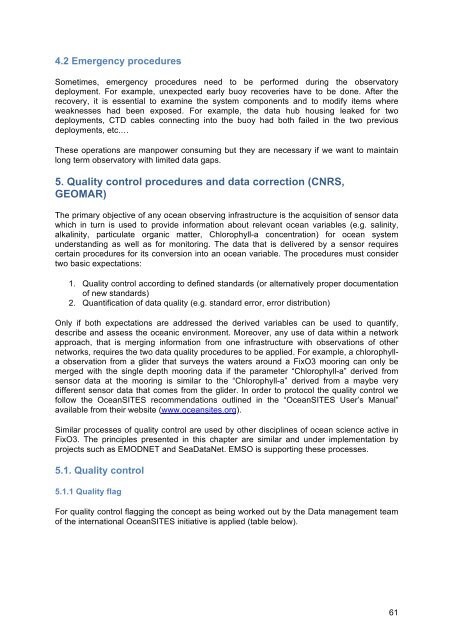Handbook of best practices
Handbook%20of%20best%20practices
Handbook%20of%20best%20practices
Create successful ePaper yourself
Turn your PDF publications into a flip-book with our unique Google optimized e-Paper software.
4.2 Emergency procedures<br />
Sometimes, emergency procedures need to be performed during the observatory<br />
deployment. For example, unexpected early buoy recoveries have to be done. After the<br />
recovery, it is essential to examine the system components and to modify items where<br />
weaknesses had been exposed. For example, the data hub housing leaked for two<br />
deployments, CTD cables connecting into the buoy had both failed in the two previous<br />
deployments, etc.…<br />
These operations are manpower consuming but they are necessary if we want to maintain<br />
long term observatory with limited data gaps.<br />
5. Quality control procedures and data correction (CNRS,<br />
GEOMAR)<br />
The primary objective <strong>of</strong> any ocean observing infrastructure is the acquisition <strong>of</strong> sensor data<br />
which in turn is used to provide information about relevant ocean variables (e.g. salinity,<br />
alkalinity, particulate organic matter, Chlorophyll-a concentration) for ocean system<br />
understanding as well as for monitoring. The data that is delivered by a sensor requires<br />
certain procedures for its conversion into an ocean variable. The procedures must consider<br />
two basic expectations:<br />
1. Quality control according to defined standards (or alternatively proper documentation<br />
<strong>of</strong> new standards)<br />
2. Quantification <strong>of</strong> data quality (e.g. standard error, error distribution)<br />
Only if both expectations are addressed the derived variables can be used to quantify,<br />
describe and assess the oceanic environment. Moreover, any use <strong>of</strong> data within a network<br />
approach, that is merging information from one infrastructure with observations <strong>of</strong> other<br />
networks, requires the two data quality procedures to be applied. For example, a chlorophylla<br />
observation from a glider that surveys the waters around a FixO3 mooring can only be<br />
merged with the single depth mooring data if the parameter “Chlorophyll-a” derived from<br />
sensor data at the mooring is similar to the “Chlorophyll-a” derived from a maybe very<br />
different sensor data that comes from the glider. In order to protocol the quality control we<br />
follow the OceanSITES recommendations outlined in the “OceanSITES User’s Manual”<br />
available from their website (www.oceansites.org).<br />
Similar processes <strong>of</strong> quality control are used by other disciplines <strong>of</strong> ocean science active in<br />
FixO3. The principles presented in this chapter are similar and under implementation by<br />
projects such as EMODNET and SeaDataNet. EMSO is supporting these processes.<br />
5.1. Quality control<br />
5.1.1 Quality flag<br />
For quality control flagging the concept as being worked out by the Data management team<br />
<strong>of</strong> the international OceanSITES initiative is applied (table below).<br />
61


